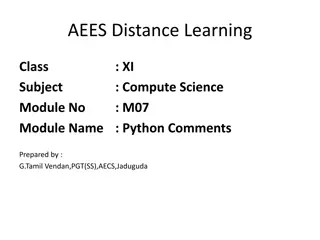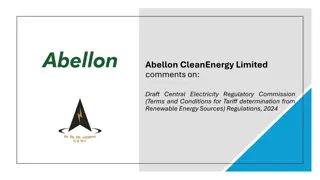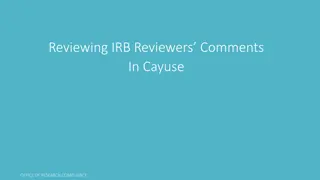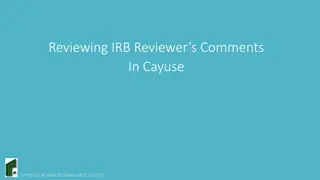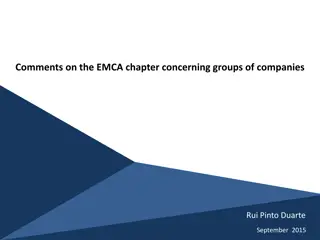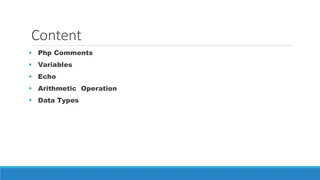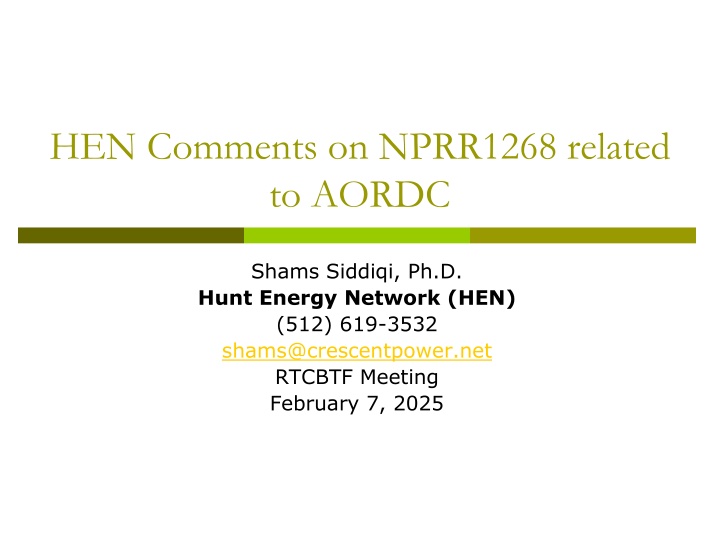
ERCOT AORDC Protocol Analysis for Operating Reserve Demand
"Explore the analysis of ERCOT's AORDC protocols regarding Operating Reserve demand and potential market price implications. Understand the use of historical data, fitting curves, and the critical evaluation of AORDC calculations for Ancillary Services procurement. Learn why utilizing unaltered ORDC for ASDCs could enhance market dynamics and avoid undervaluing AS capacity."
Download Presentation

Please find below an Image/Link to download the presentation.
The content on the website is provided AS IS for your information and personal use only. It may not be sold, licensed, or shared on other websites without obtaining consent from the author. If you encounter any issues during the download, it is possible that the publisher has removed the file from their server.
You are allowed to download the files provided on this website for personal or commercial use, subject to the condition that they are used lawfully. All files are the property of their respective owners.
The content on the website is provided AS IS for your information and personal use only. It may not be sold, licensed, or shared on other websites without obtaining consent from the author.
E N D
Presentation Transcript
HEN Comments on NPRR1268 related to AORDC Shams Siddiqi, Ph.D. Hunt Energy Network (HEN) (512) 619-3532 shams@crescentpower.net RTCBTF Meeting February 7, 2025
ERCOT Interpretation of AORDC Protocols Based on ERCOT s Ancillary Service Demand Curves (ASDCs) presentation dated 2/21/24: For all SCED intervals where (RTOLCAP+RTOFFCAP)<10,000MW, ERCOT used the historical RTOLCAP and RTOFFCAP values to calculate the composite LOLP and composite price [i.e., ORDC adder] defined as: (?.? (? ?????(??????? ?, ?.? ???,?.??? ????)) +?.? (? ?????(???????+???????? ?, ???, ????))) (???? ???(????????????, ???)) To account for lower reserve level areas where there are no historical observations, create a single point using the following assumptions: RTOFFCAP = 0, RTOLCAP = 2,000MW Set System Lambda equal to the average of system lambda, with the historical values capped at $250/MWh, during SCED timestamps with less than or equal to 4,000MW of total reserves Using the results of (a) and (b) above, use regression methods to fit a curve to the average reserve pricing outcomes for the various MW reserve levels. 2
Use ORDC instead of Adder-fitted AORDC Protocols do not define exactly what curve to fit. ERCOT chose the following curve: AORDC=(VOLL-250)*(1-CDF(RTOLCAP+RTOFFCAP, mu, sigma)) which resulted in mu=3760 and sigma=1180 ERCOT did NOT use (nor does it make sense to use) the following: AORDC = (?.? (? ?????(??????? ?, ?.? ???,?.??? ????)) +?.? (? ?????(???????+???????? ?, ???, ????))) (???? ???(????????????, ???)) [Protocols are incorrect] ERCOT could have fit a more appropriate curve for creating ASDCs: AORDC=VOLL*(1-CDF(OperatingReserve-MCL, mu, sigma)) ERCOT s use of (VOLL-250) reduces VOLL by $250/MW for entire curve ERCOT s use of (RTOLCAP+RTOFFCAP) is much greater than OperatingReserve [i.e., Ancillary Service capacity] under RTC ORDC=VOLL*(1-CDF(OperatingReserve-MCL, mu, sigma)) is by definition the Demand Curve for OperatingReserves [i.e., AS] Thus, unaltered ORDC should be used as the sloping portion of AORDC rather than the convoluted AORDC derived from simulated ORDC adder values and curve fitting an arbitrarily selected AORDC 3
Summary of HEN Changes Use unaltered ORDC [by definition the Demand Curve for Operating Reserves] to create ASDCs instead of the ERCOT-estimated [but not defined in Protocols] AORDC based on regression of simulated historical ORDC adders: this also helps mitigate some of the market price suppression with RTC implementation. ORDC Adders should not and were never used to Procure Ancillary Services and are actually lower when System Lambdas are higher in scarcity contrary to the value or what the demand curve should be for the Operating Reserve It s unclear from the Protocol language what AORDC should be fit using historical simulated data. ERCOT has chosen to fit AORDC=(VOLL-250)*(1- CDF(RTOLCAP+RTOFFCAP, mu, sigma)). This implies that the AORDC can never reach VOLL, reduces the VOLL by $250/MW/hour for the entire curve thereby undervaluing all points on the AORDC, and is further undervaluing AS capacity since AS capacity is typically much less than (RTOLCAP+RTOFFCAP). Also, there is no need to post mu and sigma values once RTC is implemented and ORDC-related OBD is no longer needed. Thus MCL, mu and sigma values should be specified is this section of the Protocols. 5




